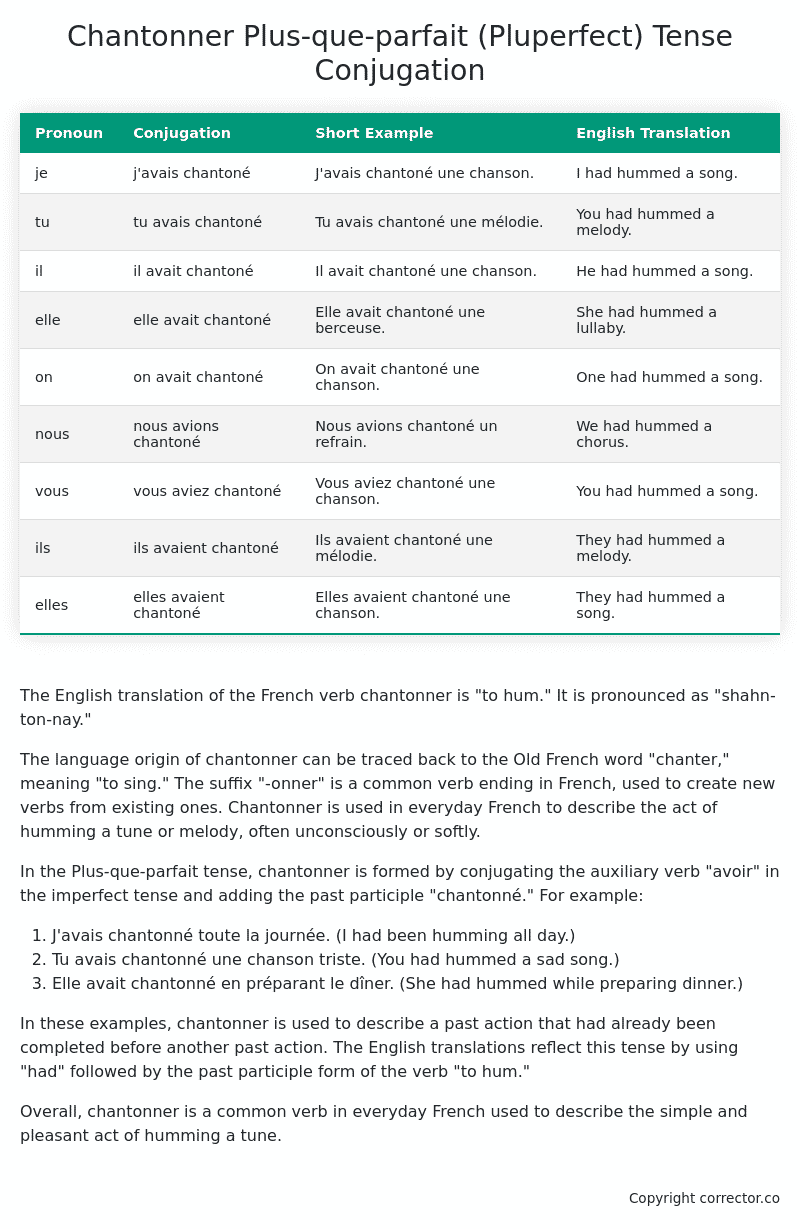Plus-que-parfait (Pluperfect) Tense Conjugation of the French Verb chantonner
Introduction to the verb chantonner
The English translation of the French verb chantonner is “to hum.” It is pronounced as “shahn-ton-nay.”
The language origin of chantonner can be traced back to the Old French word “chanter,” meaning “to sing.” The suffix “-onner” is a common verb ending in French, used to create new verbs from existing ones. Chantonner is used in everyday French to describe the act of humming a tune or melody, often unconsciously or softly.
In the Plus-que-parfait tense, chantonner is formed by conjugating the auxiliary verb “avoir” in the imperfect tense and adding the past participle “chantonné.” For example:
- J’avais chantonné toute la journée. (I had been humming all day.)
- Tu avais chantonné une chanson triste. (You had hummed a sad song.)
- Elle avait chantonné en préparant le dîner. (She had hummed while preparing dinner.)
In these examples, chantonner is used to describe a past action that had already been completed before another past action. The English translations reflect this tense by using “had” followed by the past participle form of the verb “to hum.”
Overall, chantonner is a common verb in everyday French used to describe the simple and pleasant act of humming a tune.
Table of the Plus-que-parfait (Pluperfect) Tense Conjugation of chantonner
| Pronoun | Conjugation | Short Example | English Translation |
|---|---|---|---|
| je | j’avais chantoné | J’avais chantoné une chanson. | I had hummed a song. |
| tu | tu avais chantoné | Tu avais chantoné une mélodie. | You had hummed a melody. |
| il | il avait chantoné | Il avait chantoné une chanson. | He had hummed a song. |
| elle | elle avait chantoné | Elle avait chantoné une berceuse. | She had hummed a lullaby. |
| on | on avait chantoné | On avait chantoné une chanson. | One had hummed a song. |
| nous | nous avions chantoné | Nous avions chantoné un refrain. | We had hummed a chorus. |
| vous | vous aviez chantoné | Vous aviez chantoné une chanson. | You had hummed a song. |
| ils | ils avaient chantoné | Ils avaient chantoné une mélodie. | They had hummed a melody. |
| elles | elles avaient chantoné | Elles avaient chantoné une chanson. | They had hummed a song. |
Other Conjugations for Chantonner.
Le Present (Present Tense) Conjugation of the French Verb chantonner
Imparfait (Imperfect) Tense Conjugation of the French Verb chantonner
Passé Simple (Simple Past) Tense Conjugation of the French Verb chantonner
Passé Composé (Present Perfect) Tense Conjugation of the French Verb chantonner
Futur Simple (Simple Future) Tense Conjugation of the French Verb chantonner
Futur Proche (Near Future) Tense Conjugation of the French Verb chantonner
Plus-que-parfait (Pluperfect) Tense Conjugation of the French Verb chantonner (this article)
Passé Antérieur (Past Anterior) Tense Conjugation of the French Verb chantonner
Futur Antérieur (Future Anterior) Tense Conjugation of the French Verb chantonner
Subjonctif Présent (Subjunctive Present) Tense Conjugation of the French Verb chantonner
Subjonctif Passé (Subjunctive Past) Tense Conjugation of the French Verb chantonner
Subjonctif Imparfait (Subjunctive Imperfect) Tense Conjugation of the French Verb chantonner
Subjonctif Plus-que-parfait (Subjunctive Pluperfect) Tense Conjugation of the French Verb chantonner
Conditionnel Présent (Conditional Present) Tense Conjugation of the French Verb chantonner
Conditionnel Passé (Conditional Past) Tense Conjugation of the French Verb chantonner
L’impératif Présent (Imperative Present) Tense Conjugation of the French Verb chantonner
L’infinitif Présent (Infinitive Present) Tense Conjugation of the French Verb chantonner
Struggling with French verbs or the language in general? Why not use our free French Grammar Checker – no registration required!
Get a FREE Download Study Sheet of this Conjugation 🔥
Simply right click the image below, click “save image” and get your free reference for the chantonner Plus-que-parfait tense conjugation!

Chantonner – About the French Plus-que-parfait (Pluperfect) Tense
Tense Formation
Common everyday usage patterns
Sequencing of past events
Background information
Hypothetical or reported speech
Interactions with other tenses
Summary
I hope you enjoyed this article on the verb chantonner. Still in a learning mood? Check out another TOTALLY random French verb conjugation!


